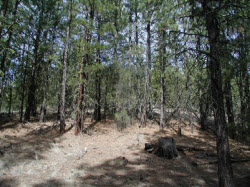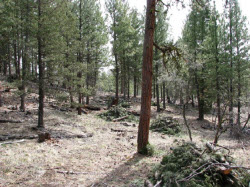
National Fire Plan Success Story
Woodtick Collaborative Fuels Reduction Project
Wallowa-Whitman National Forest, Oregon
National Fire Plan - Fuels Reduction
2009

The area before treatment.

The area after thinning, underburn to follow.
The Baker County Community Wildfire Protection Plan (CWPP) identified the Woodtick Wildland Urban Interface (WUI) as the highest at-risk WUI in Baker County. The CWPP was written to meet requirements set by the National Fire Plan and Healthy Forests Restoration Act for partnership and collaboration with local government and publics. Committee members who drafted the CWPP consisted of representatives from rural and municipal fire departments, the timber industry, Baker County Commissioners, Oregon Department of Forestry, Wallowa-Whitman National Forest, Baker Resource Area of the Vale District Bureau of Land Management (BLM), and the State Fire Marshals Office.
The Baker County CWPP identified objectives for the Woodtick WUI as: 1) Reduce wildfire risk to the wildland interface by treatment of hazardous fuels to enhance capability of firefighting resources, and 2) Use biomass to benefit the county economy. The Woodtick WUI Project was designed to achieve these objectives.
A Service First stewardship contract, involving the BLM and USDA Forest Service, was awarded in the fall of 2008 to thin federal forests with fuels treatment to follow. This contract accomplished commercial thinning and fuels treatment on 643 acres, non-commercial thinning of smaller trees and grapple piling of slash on 223 acres, and 15 acres of aspen enhancement (removal of competing conifers).
In addition to the treatments on federal lands, the Natural Resource Conservation Service, private land owners, Oregon Department of Forestry, Oregon Department of Fish and Wildlife, USDA Forest Service, and BLM collaborated to secure grants from the Rocky Mountain Elk Foundation (RMEF) and the Blue Mountain Elk Initiative for watershed enhancement, wildlife habitat improvement, and fuels reduction on 600 acres of adjacent private lands.
To-date, the removal of over 2 million board feet of timber andbiomass has helped local economies. Over 1,000 acres of pre-commercial thinning and piling have been completed on public and private lands providing jobs for local contractors. Over 1,500 acres have been under burned on National Forests with an additional 400 acres planned in the spring of 2009, including 200 acres on private lands using RMEF funds. This on-the-ground work has significantly reduced hazardous surface, ladder and crown fuels within the Woodtick WUI.
For further information, contact Steve Hawkins, Fuels Program Manager, at 541-523-1262 or sbhawkins@fs.fed.us.